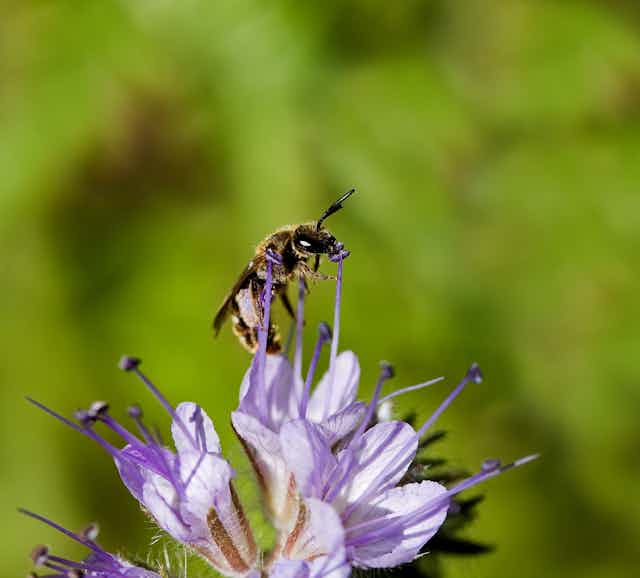Two separate studies from the United States and England, both published today, show evidence that populations of butterflies and wild bees have declined in association with increased neonicotinoid use.
Neonicotinoids, or neonics, are pesticides applied to crops as seed treatments or sprays. Neonics have high selective toxicity for insects, meaning they are more toxic to insects than mammals. When insects eat the treated plants, the pesticides affect the insects’ health, behaviour and reproductive success.
While there have been few studies in the natural environment until now, concerns about the ecological impact of neonics, including their possible link to bee declines, led the European Union to restrict their use in 2013. EU scientists are currently reviewing the ban, with recommendations expected next year.
What do the new studies tell us?
In the US study, researchers looked at 40 years of butterfly data in northern California. They found that populations declined dramatically in the late 1990s. Smaller butterfly species that produced fewer generations each year were the most affected.
These declines were associated with increasing use of neonics across the region, beginning in the mid-1990s. The data for neonics usage was obtained from US government pesticide use databases.
This study is an important contribution to our understanding of how neonics affect non-target insects in the wild.
The butterfly data was collected from four sites monitored by the same person (an expert entomologist) for up to four decades. This level of data integrity is quite rare in modern ecological studies. Long-term consistency in the data collection means that many of the effects of different observer skills or collection efforts have been minimised.
The second study looked at wild bee populations in the UK. The researchers focused on oilseed rape that had been seed-treated with the pesticide. Rape is a common source of neonics in agricultural environments and is also a highly attractive floral resource for many wild bees and other pollinator insects.
This study also uses high-quality data. It is based on 18 years of data for 62 bee species collected by the Bees, Wasps and Ants Recording Society, a specialist UK entomological society, as well as pesticide use data from the UK government. The researchers show that, over time, the negative effects of neonics exposure for wild bees outweighed the benefits of the crop as a food resource.
They provide the first evidence that neonic seed treatments are associated with national-scale declines in wild bees at the community level. Populations of species that are known to forage regularly on rape were affected three times more than species not seen on rape flowers.
Out of the lab
These studies are important contributions to science. Most previous studies showing negative effects of neonics on non-target insects have been conducted under short-term field conditions, or controlled conditions in a laboratory, using commercially bred bees (mostly European honey bees or bumblebees).
The evidence from these studies shows that while individual bees may not die immediately after exposure to the pesticides, sub-lethal effects on behaviour and health can affect their ability to pollinate crops, and impact the success of the colony as a whole.
These short-term, controlled studies tell us a lot about the biological and physiological effects of neonics on managed colonies of particular bee species. But they can’t tell us how neonics affect wild insects under natural conditions, or how consistent exposure might affect populations of other insect species over time.
The evidence from the studies published today comes from decades of data collected under natural conditions before and after neonics were introduced to the environment. It shows that neonics could affect the long-term persistence of wild pollinator communities.
Importantly, these studies also show that the biological traits of different species influence how neonics affect them. This means that results from studies of one species (e.g. commercially bred honey bees) aren’t helpful to understand impacts on other wild species.
What does this mean for Australia?
There is very little evidence of how neonics affect bees, or other non-target insects, in Australia. The Australian Pesticides and Veterinary Management Authority published a report in 2014 summarising the impact of neonics on honey bees in Australia.
The report concluded that there was a lack of consensus on causes of honey bee declines in Europe and the US. It also stated that insecticides are not a significant issue in Australia, where honey bee populations haven’t declined as we have seen overseas.
However, it’s important to remember that a lack of scientific consensus on this issue exists because very little ecological evidence is available for scientists to answer these questions conclusively.
These new studies provide evidence from specific regions in the US and UK, so we can’t extrapolate the results to Australian conditions with certainty. However, they do leave us with an important reminder that long-term monitoring is essential when trying to understand ecological systems.
In Australia, neonics are approved for use as a seed treatment in a number of crops that are attractive to honey bees and other pollinator insects. This includes canola, corn, sunflower, cotton, kale and clover.
There are still major knowledge gaps in our understanding of these insecticides, but a recent review of evidence found that neonics can persist for years in the environment and affect biodiversity through multiple pathways.
Australia has over 1,800 native bee species, many of which are providing free pollination services to many Australian crops. Thousands of other beneficial insect species living on farms – like flies, wasps, beetles and butterflies – can also be important pollinators and natural enemies. However, it is impossible to know how neonics might affect them without more comprehensive ecological research.

